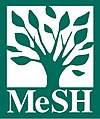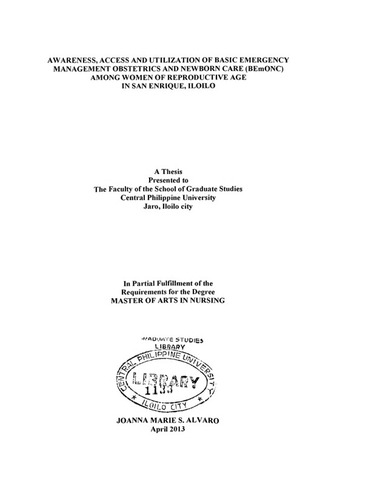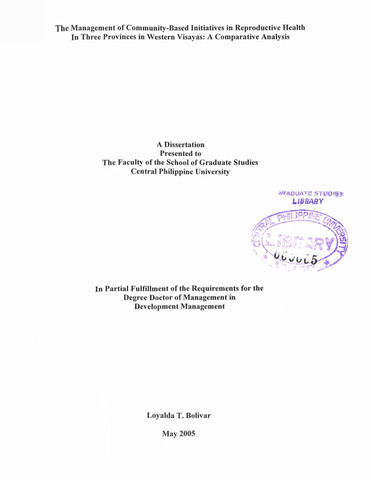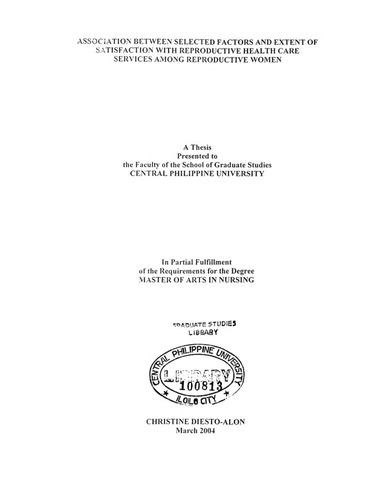Mothers’ awareness of the Kabalaka Reproductive Health Center and its program, its accessibility and extent of utilization of the services
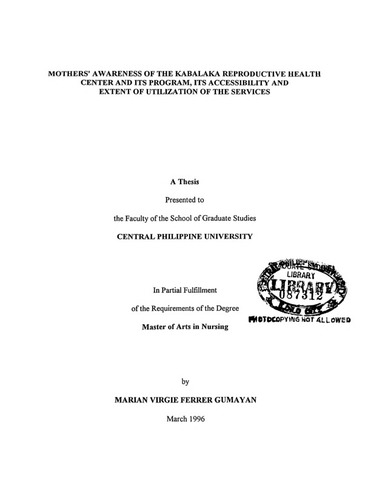
Page views
399Petsa
1996May-akda
Tagapangulo ng Panel ng Depensa
Magbahagi
Metadata
Ipakita ang buong tala ng item
Abstract
Background
This study was conducted in order to determine (1) the mothers' awareness of the services of the Kabalaka Reproductive Health Center (KRHC); (2) the mothers’ perception of the accessibility in terms of distance, location, clinic hours, clinic procedures and cost of services; (3) the extent of mothers' utilization of its services; and (4) whether awareness, accessibility and extent of utilization differ among mothers from the four barangays namely Dungon A, Dungon B, Sambag and San Isidro.
To answer the objectives of the study, an interview schedule which was face validated and translated from English to Hiligaynon was used to elicit information from the mothers in the four catchment barangays. Three hundred twenty-six mothers were randomly chosen from the four catchment barangays.
Frequency distribution, percentages, means and analysis of variance were used as statistical tools.
Summary of Findings
The majority of the mothers were aged 35 years and above, were Roman Catholics, housewives, with a total household income of P3,901.35 and below, and had small family size (2-3).
The six major health services offered by the KRHC services were maternal and child health, control of communicable diseases, genital tract infection management, cancer detection, nutrition and general services.
On the whole, the majority of the mothers (65.64 percent) were highly aware of the location of the Kabalaka Reproductive Health Center and its services. Only 16 percent of the mothers were totally unaware of both services and location. The percentages of those who knew about the different health services ranged from 0.3 percent to 49.1 percent. The specific health service most familiar to the respondents was general consultation, while the least known were referrals on nutrition, cancer detection control and genital tract management. Only 0.3 percent to 9.5 percent knew about the post-natal check-up; laboratory test, maternal and family counselling, giving of injection, giving of DMPA injection, screening of leprosy, breastfeeding and counselling, supplementary feeding, doing home deliveries, cord care, giving of baby's bath, sputum collection and collection of specimen for Papanicolau smear, other general services, history taking, iron supplement and micro-nutrient, doing breast examination, delivering and referrals of family planning clinics.
The most popular maternal and child service was the pre-natal care. This was known to more mothers in Dungon B than in any of the three other catchment areas of the center.
Family planning services was known to nearly one-half of the mothers of Dungon B and San Isidro, but to less than one-fifth of the mothers from the two other barangays.
Immunization services of the center was also known to more mothers in Dungon B than among those in the three other areas. Only 5 percent of the mothers knew about cancer detection and control, with Papanicalau smear being more known than the others.
Giving of micronutrients and Vitamin A were known to more mothers in Dungon A than in any of the three other areas. It was least known in Sambag.
In general, almost half of the mothers found Kabalaka Reproductive Health Center services easily accessible. Most of those who did were from Dungon B.
Utilization of the services of the center was rated moderate. Under the maternal care, history taking and assessment had the most number of clients, with more from Dungon B than from the other areas. Of the family planning services provided, dispensing of condoms had the most number of recipients. Only a few were able to avail of pregnancy testing services.
Child weighing, history taking and assessment and breastfeeding and supplementary counselling, and other related services were availed on by more mothers from Dungon B than those from the three other barangays. Less than 5 percent of the respondents in any of the four areas had availed of any other specific services of the center.
Most of the respondents knew about the center from their neighbors. The preferred channel of information was the nursing students doing home visits.
The reasons for utilizing the health services were: a. the center is accessible, b. Services are good and varied, c. the services are free and affordable, d. the personnel are all accommodating, and doctors are available
Among the reasons given by those who did not utilize the health center’s services were: they had their own family doctors and/or hospital plans, they were not aware of the existence of the health center or of the services provided by the center, the center is not open at all times, schedules of services are in conflict with the client’s work schedule, there are no free medicines, and they think the Center is for indigent clients only.
Conclusions
On the basis of the above mentioned findings the following conclusions were drawn:
The Kabalaka Reproductive Health Center was known to the majority of the respondents but many were not aware of the varied health services it was offering. Although, the mothers received most of their information from their neighbors as they mingled with each other, they still preferred information from nursing students when they went for house visits.
The mothers as a whole found the health services moderately accessible in terms of location, clinic hours, clinic procedures and cost of services but these health services were not fully utilized.
Services related to cancer detection control and the genital tract infection management were not used by respondents.
The respondent's perception of accessibility and extent of utilization of health services varied among the four catchment barangay. Location had a bearing on the on the mothers' awareness of and extent of the utilization of the health services and their access to the center. The farther the location of a barangay, the lesser is the mothers' awareness of, access to, and the utilization of health services of the Kabalaka Center.
Most of the mothers found health services as easily accessible in terms of distance, location, clinic hours, clinic procedures, and cost of supplies.
Less than half of the mothers utilized the health services of the center. In the areas of utilization and non-utilization of the specific health services, most of the specific health services were not utilized by the respondents.
Not one of the respondents was able to utilize the Cancer Detection Control and the Genital Tract Infection Management. These were the two specific health services which the respondents were not aware of.
The awareness of, perception of accessibility and extent of utilization varied among the mothers from the four catchment barangays. This means that location had a bearing on the mother’s awareness, perception of accessibility, and extent of utilization of KRHC health services. The farther the location of a barangay, the lesser is the level of awareness, the perception of accessibility, and the utilization of the different health services.
Recommendations
In the light of the foregoing conclusions the following recommendations and implications are given.
1. Since there were 107 out of the 326 respondents who were totally unaware of the center's location and health services, it is recommended that the information education and communication campaign about
health services offered at KHRC be intensified and that the first point of target shall be the Sambag residents
who ranked highest in unawareness.
2. Since the respondents preferred nursing students as channel of
health information, it is also recommended that the community exposure of the nursing students be broadened as part of the competency-based curriculum of the College of Nursing. This will allow students to participate actively through home visits and continuous mothers' class.
3. Since one of the major findings of the study is the lack of knowledge of the different specific health services such as genital tract infection management, cancer detection control, giving of Vitamin A capsules, family planning, deworming, iron supplement, doing cord care and baby's bath, breast and supplementary feeding, collection of specimen for Papanicolau smear examination, giving of injection and other treatments, it is recommended that:
a. concerted effort be done by the health center personnel and the university to disseminate information about these important services.
b. The programs of the center must be expanded in terms of more campaign materials, improvement of facilities, acquisition of medical supplies, increasing number of personnel, and extension of clinic hours. Although these would require more budgetary support, these expansions of services will make the center more accessible to clients. Its accessibility will lead to the full utilization of the services of the center by the clientele.
c. Kabalaka Reproductive Health Personnel conduct home visitation to encourage clientele to utilize various services of the center.
d. KRHC personnel will organize mothers' health class in the respective barangays to reinforce clienteles' knowledge and skills about various promotive and preventive health care.
4. In as much as Central Philippine University administration is viewed as a valuable coagent of Kabalaka Reproductive Health Center in community outreach, it is recommended that logistic support be extended by the University to help the Center achieve the optimum realization of the Center's program on health care services.
5. A comprehensive study on the attitude and health status of the community be done so that the program manager can make a better approach for health care delivery.
Paglalarawan
Abstract only
Mungkahing Sipi
Gumayan, M. V. F. (1996). Mothers’ awareness of the Kabalaka Reproductive Health Center and its program, its accessibility and extent of utilization of the services (Unpublished Master's thesis). Central Philippine University, Jaro, Iloilo City.
Uri
ThesisMga Paksa
Mga keyword
Kagawaran
School of Graduate StudiesDegree
Master of Arts in NursingLokasyon ng Istante
GSL Theses 610.73072 G952
Pisikal na paglalarawan
xvii, 107 leaves
Collections
Mga parehong item
Ipinapakita ang mga item na nauugnay sa pamagat, may-akda, tagalikha at paksa.
-
Awareness, access and utilization of Basic Emergency Management Obstetrics and Newborn Care (BEmONC) among women of reproductive age in San Enrique, Iloilo
Alvaro, Joanna Marie S. (2013)Women’s utilization of maternal health care facility is an important health issue with regard to the wellbeing and survival of both the mother and her child during childbirth. There are certain factors however that inhibit ... -
The management of community-based initiatives in reproductive health in three provinces in Western Visayas: A comparative analysis
Bolivar, Loyalda T. (2005)This study aimed to describe and compare the management of community-based initiatives in terms of inputs, processes used in implementation, actual project performance, facilitators and constraints in project planning and ... -
Association between selected factors and extent of satisfaction with reproductive health care services among reproductive women
Alon, Christine D. (2004)Pregnancy and childbirth are the greatest risks that many women face during their reproductive years. A report from Johns Hopkins University indicates that more than half a million women from the developing countries die ...


